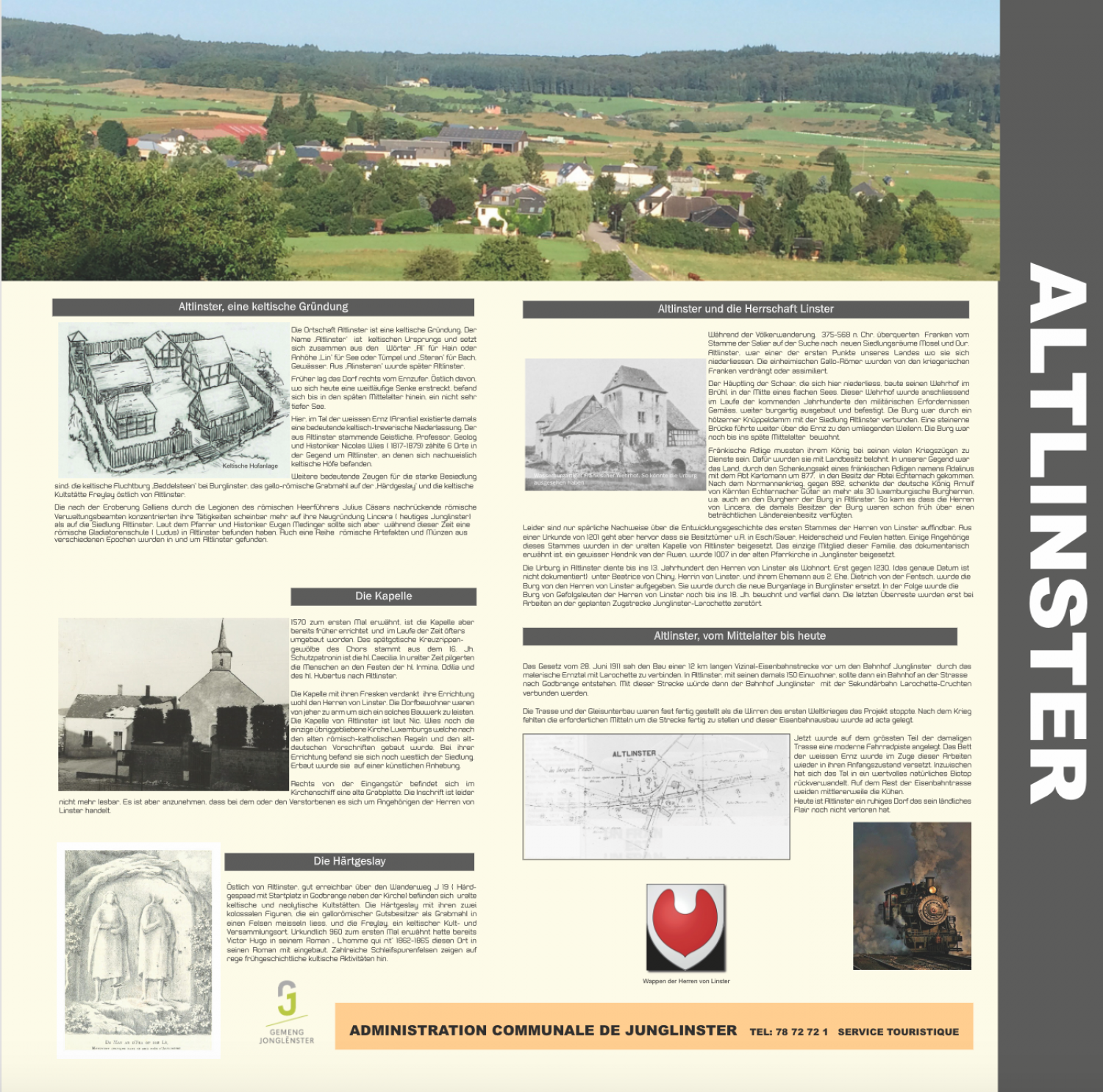Altlinster, founded by Celts

A Celtic farmstead The town on Altlinster was founded by Celts. The name “Altlinster” is of Celtic origin and is comprised of the words “al” for grove or hill, “lin” for lake or pond and “steran” for stream, water way. The name “Alinsteran” eventually became Altlinster. In the past, the village was to the right of the Ernz. To the east, where today there is a broad depression, there was a shallow lake until the late Middle Ages. At that time, here in the valley of the White Ernz (Arantia), there was an important Celtic Treveri settlement. The cleric, professor, geologist and historian Nicolas Wies (1817-1879), born in Altlinster, counted 6 sites in the area surrounding Altlinster which showed evidence of Celtic homesteads. Additional important witnesses for the significant settlement include the Celtic refuge castle “Beddelsteen” near Burglinster, the Gallo-Roman grave marker on the “Härdgeslay” and the Celtic cultic site Freylay, east of Altlinster. After Gaul was conquered by the Roman general Julius Caesar, the bureaucrats who followed after the legions seemed to concentrate more on their newly founded Lincera (today Junglinster) than the settlement of Altlinster. According to the pastor and historian Eugen Medinger, at this time there was a Roman gladiator training school (ludus) in Altlinster. A series of Roman artifacts and coins from various epochs have been found in and around Altlinster. The Chapel First mentioned in 1570, the chapel was first built much earlier by the Lords of Linster. The villagers had always been too poor to afford such a building. According to Nic. Wies, the chapel of Altlinster is the last remaining church in Luxembourg built according to the old Roman-Catholic rules and the old German regulations. When it was built, it was still located to the west of the settlement on an artificial hill. To the right of the entrance there is an old gravestone in the nave. Sadly, the inscription is no longer legible. However, it can be assumed that the person or persons buried there were relatives of the Lords of Linster. The Härtgeslay East of Altlinster, easily reachable via Hiking Path J 19 (Härdgespaad, starting in Godbrange near the church), there is an ancient Celtic and Neolithic cultic site. The Härtgeslay with its two colossal figures, commissioned to be chiseled into the boulder as a grave stone by a Gallo-Roman landowner, and the Freylay, a Celtic cultic and gathering site, were first mentioned in 960. Victor Hugo included this site in his novel “L’homme qui rit” (1862-1865). Numerous grinding traces point to lively prehistoric cultic activity at the site. Altlinster and the Lords of Linster [Image:] Frankish defensive castle with moat. The original castle may have looked like this. During the migration of 375-568 CE, Franks from the tribe of the Salier looking for new places to settle crossed the Mosel and Our. Altlinster was the first place they settled in our country. The local Gallo-Romans were displaced or assimilated by the war-like Franks. The chief of the horde that settled here built his defensive castle in Brühl in the middle of a shallow lake. Over the coming centuries, this defensive castle was then further developed and fortified as a castle to keep up with the changing military demands. The castle was connected to the settlement of Altlinster via a wooden corduroy road/ A stone bridge led further over the Ernz to the surrounding hamlets. The castle was occupied until late in the Middle Ages. Frankish nobles were obliged to serve their king in his many wars. For this, they were rewarded with land ownership. In our region, the land came into the possession of the Abby Echternach thanks to the donation of a Frankish nobleman names Adalinus to Abbot Karlomann around 877. After the Norman war, around 892, the German king Arnulf von Kärnten gave estates in Echternach to more than 30 lords of castles in Luxembourg, including the lord of the castle in Altlinster. In this way, the Lords of Lincera, who owned the castle at that time, came early into the possession of a significant landholding. Unfortunately there is little evidence of the development of the first family of the Lords of Linster. According to a certificate from 1201, that they had holdings, among other places, in Easch/Sauer, Heiderscheid and Feulen. Some members of this family were buried in the ancient chapel of Altlinster. The only member of the family mentioned in documents was a certain Hendrik von der Awen, who was buried in 1007 in the old parish church in Junglinster. Altlinster, from the Middle Ages to today The law passed on June 28, 1911 was intended to build a 12 km long railway branch line in order to connect the train station at Junglinster to Larochette via the painterly Ernz valley. In Altlinster with its 150 residents at the time, was to have received a train station in the street near Godbrange. This route would connect the Junglinster station with the secondary line of Larochette-Cruchten. The embankment and track support were nearly completed when the chaos of the First World War stopped the project. After the war, the necessary means were no longer available to finish the stretch and this new rail construction was considered finished. Now, along the majority of the old embankment there is a modern bicycle path. As part of this work, the bed of the White Ernz was restored to its original condition. In the meantime, a valuable natural biotope has developed in the valley. Cows now graze on the rest of the rail line. Today, Altlinster is a quiet village that has not lost its rural flair.
Download Flyer (PDF)